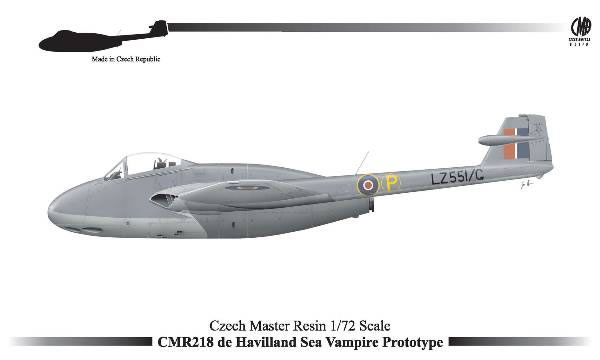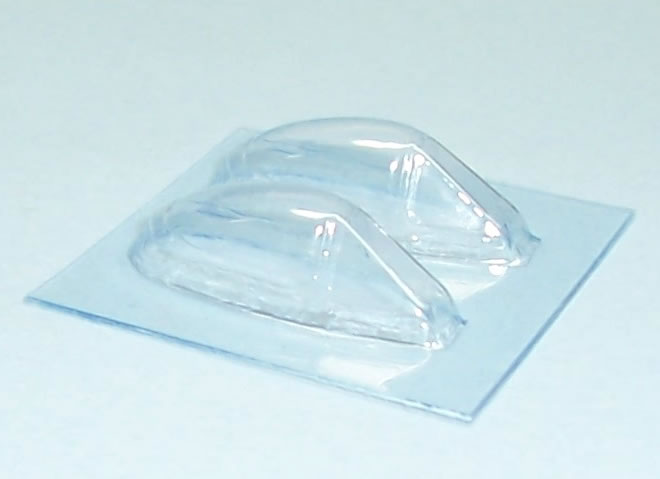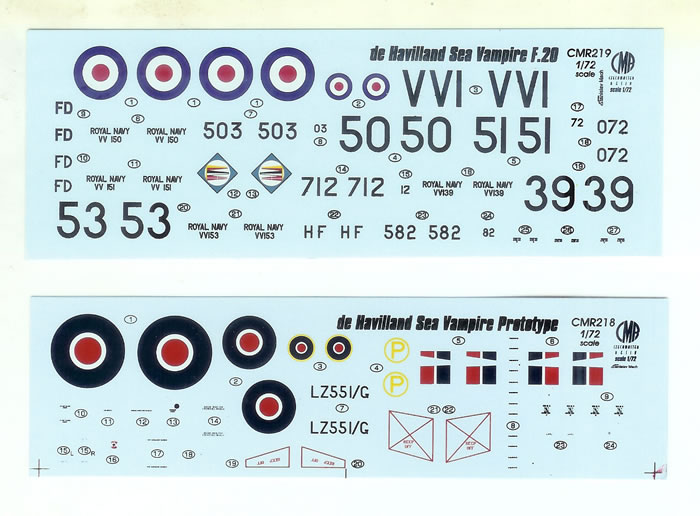de Havilland Sea Vampire
Prototype & F.20

Czech Master Resin, 1/72 scale
S u m m a r y : |
Catalogue Number: |
Czech Master Resin
CMR218 - Sea Vampire Prototype
CMR219 - Sea Vampire F.20 |
Scale: |
1/72 |
Contents & Media: |
Both kits have 57 x cream resin airframe parts, 7 x black resin undercarriage parts, 1 x Eduard coloured PE fret of detail parts, 2 x vac-from acetate canopies & 1 x Eduard pre-cut paint mask.
The Prototype has one decal option, and the F.20 four options. |
Price: |
Sea Vampire kits available on-line from
Other CMR stockists can be found here, and click here for currency conversion. |
Review Type: |
First Look |
Advantages: |
High quality, superbly detailed and very comprehensive kits. |
Disadvantages: |
None apparent. |
Conclusions: |
Suited to modellers with some resin and multi-media experience. Superb kits. |
Reviewed
by Mark Davies

HyperScale is proudly supported by Squadron.com
First let’s look at land-based single-seat Vampires -The MK I had a very short endurance so the next production version, the F.3, improved on this by adopting more internal tankage and the ability to carry drop-tanks. The opportunity was also taken to fit the more powerful Goblin. The RAF focussed on the Meteor as its jet interceptor, but the Vampire was well suited to specialise as a fighter-bomber. So the FB.5 was developed with a strengthened wing, clipped wingtips to enhance low-level handling, and strong points for up to 2,000 lbs. of stores were added. The undercarriage was strengthened to cope with the faster sink speeds on landing. The FB.9 that followed was essentially a tropicalised FB.5 with a little more power and air conditioning.
In parallel with these developments was an interest in the Vampire for carrier-borne use by the Fleet Air Arm. The first steps were taken using the second Vampire prototype LZ551/G. It was fitted with the more powerful Goblin 2 engine, was given larger flaps and air-brakes to combat float due to the low wing’s proximity to the deck upon landing, and of course it had an arrester hook. It was also fitted with the later style canopy, plus the pitot was moved from the fin to the port wing to better cope with high angles of attack. On 3 December 1945 this aircraft was flown by Lt Cdr Eric Brown onto HMS Ocean, becoming the jet to land on a ship.
The Admiralty decided that the Vampire as tested was unsuitable for carrier use primarily due to poor throttle response and short endurance (characteristics that afflicted all early jet aircraft). Specifications were issued for modified Vampire design to be known as the Sea Vampire F.20. 30 were ordered in 1947 but this was reduced to just 18 in 1948. The F.20 was based on the FB.5 described earlier, but had 31% larger flaps and air-brakes, was fitted with a V-shaped arrester hook under a fairing above the jet pipe, long stroke undercarriage and catapult points. The Sea Vampire F.20 began to enter service over 1949/50 but it had a short service life, being replaced by the Sea Venom in 1955. But it had served its purpose by giving the RN experience operating jet fighters from carriers.
Just to complete the story, mention should be made of the six Sea Vampire F.21’s which were modified F.Mk3’s without undercarriages and had strengthened bellies for trials with flexible rubber decks (the idea being to save weight and so enhance performance and range). The system worked, but thankfully was abandoned!
Previous Vampire FB.9’s in 1/72 Scale
I’m unaware of previous single-seat Sea Vampire kits in 1/72 (although CMR offers the twin-seat Sea Vampire T.22). CMR’s release of these two kits is therefore welcomed as it enables modellers to fill an important gap in early post-war FAA aviation.
CMR is working its way through all the major Vampire variants in 1/72 scale, and these two Sea Vampires are the latest of the single seat versions. These latest kits follow the established format of previous single-seat Vampire releases and are described below.
Both kits come packaged in CMR’s now standard sturdy top-opening box. The parts and decals are in heat-sealed plastic bags, which in turn are sealed in a further bag with the instructions and photo-walkaround. The instructions have excellent graphics and consist of double-sided A4 pages (see here for the Prototype and here for the F.20). The parts map and constructional illustrations are very clear and easy to follow. More double-sided pages give comprehensive colours and markings plans. Colour notes and other written instructions are in English. Yet more double-sided pages provide an excellent photo walkaround focused on various aspects of the aircraft. The kits share most parts other than wings and tail booms.

The parts are very nicely moulded with no pinholes or other obvious flaws, with the one exception in the case of my Sea Vampire prototype. It had a couple of bubbles below the surface on one tail boom (the first flaw I’ve found in ages in a CMR kit after numerous reviews). However this will be easily remedied. A little flash is evident in a couple of places, but this can be removed easily and in seconds. The undercarriage in both cases is in a black resin that provides greater strength than the cream resin for fine weight-bearing parts.
Both kits are awash with detail. Considerable attention to detail has been paid to the cockpits, wheel wells and flap bays. Detail levels are further enhanced by the pre-coloured Eduard PE sets provided.
Don’t be fooled from the accompanying images into thinking that there is flash on the flaps and air-brakes. The very thin surfaces on these parts are replicating the way the real aircraft had the surface area of these flying surfaces increased.
Each kit has two copies of the canopy to provide for insurance or practice when cutting out. They come with an Eduard pre-cut mask which simply serves to make life easy when it comes to painting.

Decals are typical of CMR, being well registered and suggest good opacity. Based on past experience they should be very good to use. The Prototype LZ551/G is Dark Sea Grey over Sky and has yellow “P’s” in a ring to indicate that it is a prototype.

The F.20 options are all Extra Dark Sea Grey over Sky and cover the following aircraft:
-
VV150 - FD-503 of No.771 Naval Air Squadron, RNAS Ford, July 1953.
-
VV139 - 072 of No.703 Naval Air Squadron, RNAS Ford, 1953.
-
VV153 - HF-582 of No.728 Naval Air Squadron, Hal Far, Malta, 1954.
-
VV151 - FD-712 of No.764 Naval Air Squadron, RNAS Ford, 1956.
These are superbly executed kits with very high levels of detail. Despite their tiny details and twin-boom layout they should assemble in a straightforward manner. Surely these are the definitive Sea Vampire Prototype and F.20 kits - Highly recommended.
Thanks to Czech Master Resin for this review sample.
Thanks to Czech Master Resin for this review sample.
CMR Models are available
online from Hannants in the UK,
Red Roo Models in Australia
and
quality specialist model retailers worldwide.
Text Copyright © 2011 by Mark Davies
This Page Created on 13 April, 2011
Last updated
8 June, 2011
Back to HyperScale
Main Page
Back to Reviews
Page
 |
